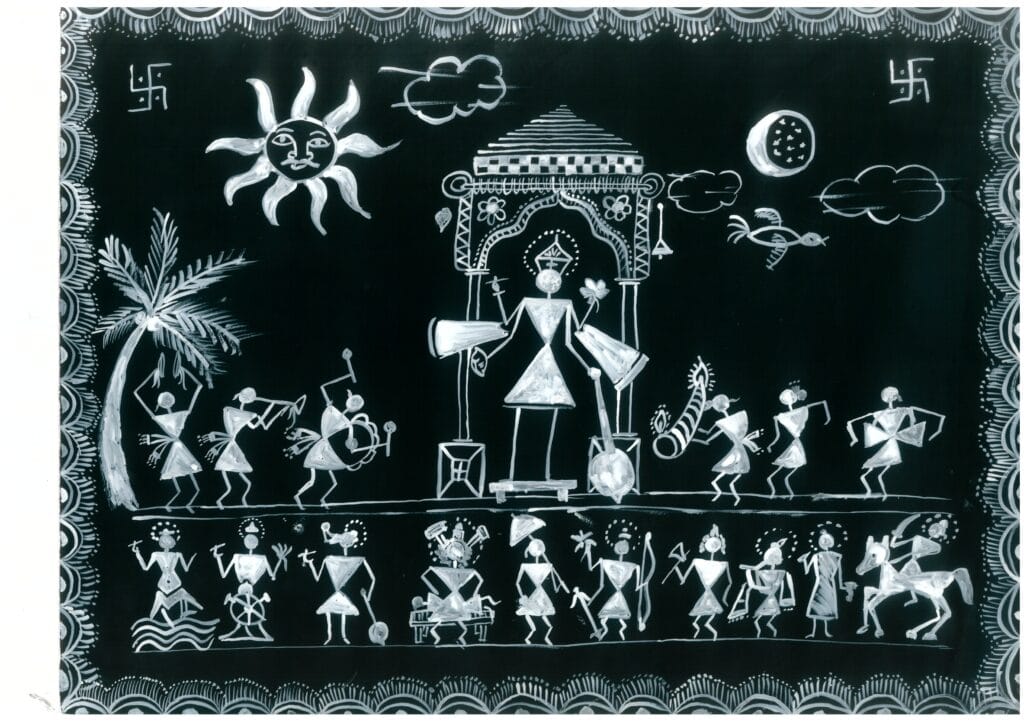Out of small villages of the Warli community where the people still live in mud huts and cook their food over wood fires comes an art that looks simple at first glance, but which actually contains whole stories about the lives of its artists. This art form has now become popular all over the world. I have moved a little away from the traditional depictions of everyday life to paint a scene depicting the ten avatars of the Hindu god Vishnu.
Painting:

Warli is an ancient type of art practiced by the people of the Warli community, who live in the rural areas of the Western Maharashtra, India. They are an agriculture-based economy and lead a relatively primitive life which reflects in their art. Warli art revolves around the lives of the villagers. It includes simple depictions of natural objects such as people, animals, plants, the sun and the moon, and clouds.
Instead of paint, the villagers prepare a slurry of rice flour and water, with which they create these paintings on the walls of their houses. They mostly live in mud houses which are dark brown in colour. Therefore, even in normal practice, the paintings are made on a dark-coloured background, usually brown, black, or olive green. Also, it is a custom within their community to always make these paintings on their houses if the family or village has experienced a memorable event. It is like a status symbol. For example, if there is a marriage in the family, a picture depicting a marriage procession will be painted on the family’s house walls.
My painting depicts villagers celebrating a festival. The large figure in the centre is that of the Hindu god Vishnu, also known as the preserver of the universe. The three figures on either side of him are villagers playing musical instruments and dancing to the music.
The ten figures at the bottom represent Lord Vishnu’s “Dasha-avatara” or ten incarnations. He is believed to have taken birth on earth nine times. They were: a fish (matsya avatar, which helped King Manu in saving the world during the ‘pralay’ – similar to Noah’s ark during the Biblical floods), a turtle (kurma avatar), a boar (Varaha avatar), half-man half-lion (Narasimha avatar), a dwarf (Vamana avatar), the sage Parshurama, Lord Ram, Lord Krishna, and Lord Buddha (in South India, Vishnu’s 9th incarnation is believed to be Balarama). The tenth figure represents Vishnu’s 10th avatar Kalki, who is yet to appear on earth.
In India, there is no specific festival dedicated to Lord Vishnu, so the villagers may be celebrating a festival related to either Lord Ram or Lord Krishna. The instruments played by the villagers include cymbals, trumpets, drums, and mridangam. The first person to the right of Lord Vishnu’s idol is playing an instrument called tarpa. Tarpa is a local musical instrument which is made using hollowed-out gourds and is similar to a trumpet.
For the painting itself, I have used an A3 sized 140 gsm paper. I have used black poster colour to paint the background. I have used white poster colour and a 0 sized brush for the rest of the painting. Also, I have used a more diluted form of the white paint. It gives a slightly patchy effect, which resembles the actual paintings that are done using rice slurry. I have not used any instruments like rulers, neither have I used pencils to trace out the figures first.
So I hope you liked the painting. There are a lot of other customs that are followed while making these paintings. I will explain them in detail in my next post, where I have another Warli painting to show you. So stay tuned and please subscribe if you haven’t already. Au Revoir!
